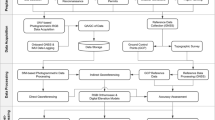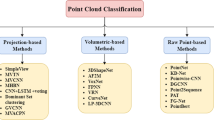Abstract
A terrestrial laser scanner (TLS) measures individual point with a precision in the order of millimeters. The evaluation of point cloud precision, although directly affecting the application of TLS like the precision of deformation extraction and digital elevation model (DEM) reconstruction, is still not well understood. Point cloud precision is different from individual point precision, which was influenced by positional error and the adjacent error spaces. This paper is focused on a new evaluation model of point cloud precision based on the point cloud error ellipsoid. The kernel of this model is the computation of the overlap of adjacent error ellipsoid and the determination of functional relationship between average error ellipsoid volume and point cloud accuracy. Furthermore, the effectiveness of the evaluation model of point cloud precision is discussed with a validation experiment. This paper briefly outlines the key advantage of the proposed evaluation model, such as the capability of providing local point cloud precision of building or other architecture approximately plane.











Similar content being viewed by others
References
Ahokas, E., Kaartinen, H., & Hyyppä, J. (2004). A precision assessment of repeated airborne laser scanner observations. Proceedings of the XXth ISPRS Congress, July 2004, Istanbul, Turkey, International Archives of Photogrammetry, Remote Sensing and Spatial Information Sciences, XXXV(B3/III):237–242.
Armesto, J., Ordóñez, C., Alejano, L., & Arias, P. (2009). Terrestrial laser scanning used to determine the geometry of a granite boulder for stability analysis purposes. Geomorphology, 106(3), 271–277.
Bitelli, G., Dubbini, M., & Zanutta, A. (2004). Terrestrial laser scanning and digital photogrammetry techniques to monitor landslides bodies. International Archives of Photogrammetry, Remote Sensing and Spatial Information Sciences, 35(Part B5), 246–251.
Crombaghs, M., & Elberink, S. O. (2002). Assessing height precision of laser altimetry DEMs. In: R. Brügelmann, E. Min (Eds.), ISPRS Commission III, Vol. 34, Part 3B “Photogrammetric computer vision” (p. A-85ff). Graz.
Du, Z., Wei, Y., & Yao, Z. (2009). Analysis of laser radar measurement system based on error ellipsoid model. Journal of Shang Hai Jiao Tong University, 43(12), 1881–1885.
Feng, Q., Wang, G., Röshoff, K. (2012). In Investigation of 3D terrestrial laser scanning techniques for potential application to rock mechanics (pp. 963–968).
Golparvar-Fard, M., Bohn, J., Teizer, J., Savarese, S., & Peña-Mora, F. (2011). Evaluation of image-based modeling and laser scanning precision for emerging automated performance monitoring techniques. Automation in Construction, 20(8), 1143–1155.
Grant, D., Bethel, J., & Crawford, M. (2012). Point-to-plane registration of terrestrial laser scans. ISPRS Journal of Photogrammetry and Remote Sensing, 72, 16–26.
Grussenmeyer, P., Alby, E., Assali, P., Poitevin, V., Hullo, J. F., & Smigiel, E. (2011). In: Accurate documentation in cultural heritage by merging TLS and high-resolution photogrammetric data, Videometrics, Range Imaging, and Applications XI, vol. 8085, SPIE. Munich: The Society of Photo-Optical Instrumentation Engineers.
Kager, H., & Kraus, K. (2001). Height discrepancies between overlapping laser scanner strips. In Proceedings of Optical 3D Measurement Techniques V (pp. 103–110). Vienna.
Lam, S. Y. W. (2006). Application of terrestrial laser scanning methodology in geometric tolerances analysis of tunnel structures. Tunnelling and Underground Space Technology, 21, 3–4.
Lohmann, P., & Koch, A (1999). Precision assessment of laser-scanner data. Proc. Joint ISPRS Workshop “Sensors and mapping from space”, Hannover, Germany (on CD-ROM).
Maas, H.-G. (2002). Methods for measuring height and planimetry discrepancies in airborne laserscanner data. Photogrammetric Engineering & Remote Sensing, 68(9), 933–940.
Rönnholm, P. (2004) The evaluation of the internal precision of laser scanning strips using the interactive orientation method and point clouds. volume XXXV-3/W3 part B, Istanbul, Turkey, XXth ISPRS Symposium - International Archives of Photogrammetry and Remote Sensing.
Schaer, P., Skaloud, J., Landtwing, S, & Legat, K. (2007). Precision estimation for laser point cloud inclouding scanning geometry. Mobile Mapping Symposium, 1–8.
Soudarissanane, S., Linenbergh, R., Menenti, M., & Teunissen, P. (2011). Scanning geometry: Influencing factor on the precision of Terrestrial laser scanning points[J]. Journal of Photogrammetry and Remote Sensing, 389–399.
Tang, P., Huber, D., Akinci, B., Lipman, R., & Lytle, A. (2010). Automatic reconstruction of as-built building information models from laser-scanned point clouds: a review of related techniques. Automation in Construction, 19(7), 829–843.
Toth, C., Paska, E., & Brzezinska, D. (2008). Precision assessment of lidar data by using pavement markings. Presented at ASPRS Annual Conference, Portland, Oregon, USA. 10 pages.
Acknowledgments
This research is supported by National Natural Science Foundation of china (41501502, 41464001, 41304001); CRSRI Open Research Program (CKWV2015230/KY)
Author information
Authors and Affiliations
Corresponding author
About this article
Cite this article
Chen, X., Zhang, G., Zhang, J. et al. An Average Error Ellipsoid Model for Evaluating Precision of Point Cloud from TLS. J Indian Soc Remote Sens 44, 865–873 (2016). https://doi.org/10.1007/s12524-016-0563-8
Received:
Accepted:
Published:
Issue Date:
DOI: https://doi.org/10.1007/s12524-016-0563-8




